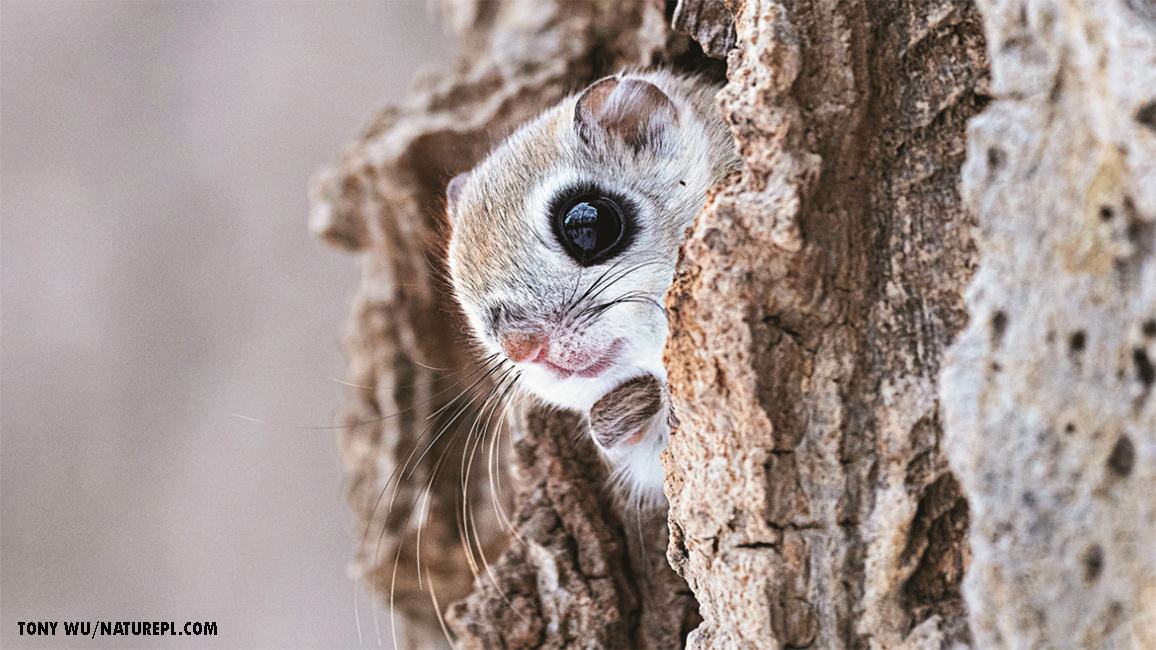
Siberian Flying Squirrels
By Anne Cissel; photos by Tony Wu/Naturepl.comSay hello to the adorable, furry creatures that “fly” in the forests of northern Japan.
What could be cuter than this little squirrel peering out of its tree-hole den?
You’re lucky to even see a Siberian flying squirrel this close up. Most people never get a chance.
But thanks to one very patient photographer and an unusual group of squirrels, we get this rare look!

There are several kinds of Siberian flying squirrels. But the kind in this story lives only on the Japanese island of Hokkaido (hoh-KAI-doh).
Photographer Tony Wu spent many cold hours in the forest, waiting for some of these squirrels to appear.
He was helped by their unusual behavior.
Flying squirrels are normally nocturnal (nok-TURnuhl), or active at night.
Oddly, the squirrels Tony photographed were awake and moving around during the day!
He thinks they were avoiding two owls that had been hunting squirrels after dark. Whatever the reason, it made it much easier to take pictures of them. Fly over to check out these charmers!
SQUIRREL SCHEDULE
What do these squirrels do up in the treetops? Glide from tree to tree, of course—but more on that later.
Much of their time is taken up looking for food. They eat the trees! Well, at least PARTS of the trees: flowers, nuts, buds, leaves, seeds, and fruits.
They either eat on the go or store snacks for later.
Tony spotted one of these squirrels using an old, empty bird nest as a food cabinet!

For sleeping, they build nests in tree holes—often ones left by woodpeckers.
They line their nests with moss or other soft stuff. In the winter, a few squirrels will cozy up together in a hole to stay warm.
KITTEN TIME
When it’s time for mating, there’s a lot of fighting between males over the females.
Tony saw many scuffles, with two males swatting and chasing each other—and even wrestling in mid-air.
Once the battles are over, the mating begins.
About five weeks later, the females give birth to two to six babies, or kittens.

Each kitten weighs less than a nickel when it is born. (An adult weighs less than a smartphone!)
The kittens—born hairless and with eyes closed—stay in the nest for a month or so.
But after about two months, they’re ready to move out and live on their own. They need to be careful out there, though.
DANGER LURKS
Foxes, owls, and other predators hunt the flying squirrels.
To avoid becoming meals, the squirrels need to be alert and move quickly.
That’s when being able to glide can be a big help.
So let’s see how that works!
A GLIDE IN SLO-MO! HOW A FLYING SQUIRREL GLIDES
A flying squirrel rarely touches the ground. It eats, sleeps, and raises its family in the trees. But it does need to move between trees, especially to find enough to eat.
That’s why it’s useful to know how to soar.
Also, it’s harder for enemies to catch a squirrel in the air than on the ground.
But a flying squirrel doesn’t fly the way a bird or a bat does.
It uses flaps of skin between its arms and legs to glide. The flaps of skin are called patagia (puh-TAY-jee-uh).
The photo spread across these pages shows just one squirrel sailing between two trees.
Tony took a series of high-speed photographs of the squirrel in motion. Then he put the photos together to show the “flight” in detail. This squirrel traveled more than 13 feet in less than half a second!

Tony took the first photo in the series (bottom left) after the squirrel had dropped from a high branch on a nearby tree.
By spreading its patagia wide (left circle), the squirrel caught the air and soared up toward the other tree.
Doesn’t it look like a kite or a hang glider?
To slow down at the end of its glide, it cupped its patagia by pulling its arms and legs forward to form a “parachute” (right circle).
While soaring, a flying squirrel can zig and zag by moving its arms and legs. It can even do a U-turn in mid-air!
Its tail helps it steer, too, and acts as a brake during landing.
A flying squirrel can glide more than 150 feet. That’s the length of 10 cars, parked bumper to bumper!
At first, Tony didn’t know when a squirrel might “fly.” But he remained focused, ready to capture the lightning-quick movement the moment it began. Over time, he learned to recognize a certain look in a squirrel’s eyes that meant, “It’s time to take off!”
This group of squirrels eventually went back to being nocturnal.
But their brief time as daytime gliders gave us an incredible peek at one of nature’s coolest creatures.
Want to see this “flight” in action? Tap the video below to watch!


















